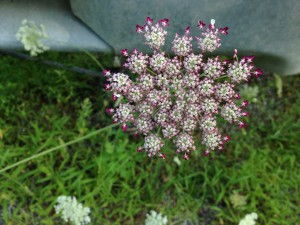Hello fellow readers,
While on a road walk with Miss Ellie, I saw a pinkish Queen Anne’s Lace flower with dark magenta edges on a plant where all the other flowers were the customary cream. What a gorgeous anomaly! It reminded me of grade school when we’d cut Queen Anne’s Lace and put them in water with food coloring to change the color.
Queen Anne’s Lace, Daucus carota, is also called Wild Carrot. In fact, today’s edible carrots were once cultivated from this plant. Like carrots, the D. carota root is edible while young before becoming too woody to eat. Be careful when collecting Queen Anne’s Lace as it resembles Poison Hemlock and Fool’s Parsley, both with similar flowers. But the Queen Anne’s Lace flowers are much tighter, and only her roots smell like carrots. She’s second to beets in the sugar level and is sometimes used to sweeten puddings and other foods.
They say both Queen Anne of Great Britain and her great grandmother Anne of Denmark is for whom the plant is named. Once introduced to North America, she naturalized and thrived in dry fields, ditches, and other open spots. She blooms from May to October and, as a biennial, lives for two years and only blooms in her second year. Each flower cluster is tiny white flowers that resemble lace. Some have a teeny dark red flower in the center and, as the story is told, represent a blood droplet where Queen Anne pricked herself while making the lace.
“So, is it a weed or a wildflower?” asked my better half Curt. ‘A weed is a misplaced plant,’ my standard response, as many plants in the wild (and in my garden) are keepers though others may consider them weeds.
Queen Anne’s Lace is a companion plant to crops. It can boost tomato plant production when kept nearby and provide a microclimate of cooler, moister air for lettuce when intercropped with it. On the other hand, the USDA has listed it as a pest in pastures as its seeds persist for two to five years. Yet beneficial bugs such as caterpillars of the Eastern Black Swallowtail butterfly eat the leaves, and pollinators drink the nectar. So a weed or a wildflower? It’s in the eye of the beholder, and she’s a beauty!
Garden Dilemmas? AskMaryStone@gmail.com and your favorite Podcast App.
Column Updated 8/7/22
You’ll enjoy Episode 18 of the Garden Dilemmas Podcast:
I came across a Queen Anne’s Lace jelly recipe which sounds ticklish on the tongue to me but may be worth a try:
2 cups fresh Queen Anne’s lace flowers
4 cups water
1/4 cup lemon juice
1 package powdered pectin
3 1/2 cups plus 2 tbsp. organic cane sugar
Bring water to a boil. Remove from heat and let cool for 5 minutes. Add flower heads and push them down into the water until fully covered. Cover and steep for one-half hour. Strain.
Measure 3 cups of the liquid into a pot. Add lemon juice and pectin. Stirring constantly, bring to a rolling boil. Add sugar and stir constantly. Cook and stir until mixture comes to a rolling boil, then boil one minute longer. Remove from heat. Skim.
Pour into sterilized jars leaving 1/4″ head space—then process in a hot water bath for 5 minutes.
Found on: http://www.ediblewildfood.com/queen-annes-lace.aspx




